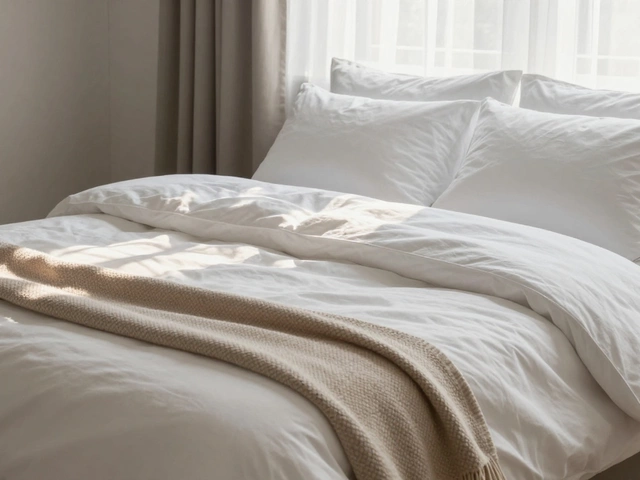Medicare Coverage: Mattresses for Seniors Explained

If you or a loved one are navigating the ins and outs of Medicare, you might be wondering about mattress coverage. Here's the scoop: Medicare is pretty particular about what it will pay for when it comes to bedding. Regular mattresses don't make the cut, but there are exceptions.
Medicare covers certain beds if they're deemed 'medically necessary.' What does that mean? Think of adjustable beds or beds specifically designed to help with medical conditions, like pressure-relief mattresses for those with severe mobility issues. It's not about luxury; it's about health.
So, how do you know if you qualify for this type of coverage? It often hinges on documentation from your healthcare provider stating why a specific bed is needed to manage a medical condition. And let’s not forget about Medicare Advantage plans, which sometimes offer broader coverage. It might be worth looking into if a specialized mattress is what you need.
- Understanding Medicare Basics
- When Mattresses Are Covered
- Medically Necessary Equipment
- Exploring Supplement Plans
- Tips for Better Sleep
Understanding Medicare Basics
Dipping your toes into the realm of Medicare can feel a bit like learning a new language. But don't worry, we've got you covered. Let's break it down. Medicare is a federal health insurance program primarily for people aged 65 and over, though folks with certain disabilities might also qualify.
Here's a quick peek at its structure: Medicare is split into different parts. You have Part A, which covers hospital stays and some aspects of home healthcare. Then there's Part B that takes care of outpatient care, doctor visits, and preventive services. Together, these cover a broad range of medical needs, but they're sometimes light on specialized equipment like specific mattresses.
"Medicare Part A and B rarely include long-term care or most dental, vision, and foot care," explains the National Institute on Aging.
Now, the part that a lot of folks get mixed up about is Medicare Advantage, or Part C. These are plans offered by private companies that are approved by Medicare. They include everything from Parts A and B, plus often toss in extras like drug coverage or specialized health aids.
Eligibility and Enrollment
To qualify for Medicare, you generally need to be a U.S. citizen or a permanent resident, and at least 65 years old. If you’re already getting benefits from Social Security, you’ll be automatically enrolled in Parts A and B when you're eligible.
| Medicare Part | Coverage Details |
|---|---|
| Part A | Hospital care, some home healthcare. |
| Part B | Doctor visits, outpatient care, preventive services. |
| Part C | Includes Parts A & B plus extras, like drug coverage. |
So what does all this mean for getting coverage on specialized mattresses? In most cases, you'd need a doctor's note stating the mattress is medically necessary - and even then, it's about meeting specific criteria. It's helpful to know the ins and outs of your particular plan, as some Medicare Advantage policies might offer better options.
When Mattresses Are Covered
Understanding when Medicare covers a mattress can save both money and frustration for senior citizens who need more than just a comfortable place to sleep. Generally, regular mattresses don’t get the thumbs-up from Medicare unless they fit very specific criteria. So, what are those?
Medically Necessary Mattresses
Medicare does cover mattresses if they're deemed necessary for medical reasons. This means that the mattress must be part of 'Durable Medical Equipment' (DME) like hospital beds or pressure-reduction mattresses for those who need them. These are often for patients with severe mobility issues or chronic conditions like bed sores.
Medicare.gov explains, 'Medicare Part B (Medical Insurance) covers medically necessary durable medical equipment if your doctor prescribes it for use in your home.'
Steps to Get a Covered Mattress
If you think you or someone you care for might qualify, here's what you need to do:
- Get a prescription: Your healthcare provider must provide documentation stating the medical necessity of the special mattress.
- Verify with Medicare: Check if the specific mattress or bed is listed under Medicare-approved DME.
- Use Medicare-enrolled suppliers: To ensure coverage, purchase from suppliers who are enrolled with Medicare.
It can sound tricky, but understanding these steps can help you navigate the process more smoothly. And it's worth the effort if a medically necessary mattress can improve quality of life.

Medically Necessary Equipment
When it comes to Medicare coverage, understanding what falls under 'medically necessary equipment' can be the key to unlocking benefits for those special mattresses. We're talking about instances where a regular bed just doesn't cut it for health reasons. This typically applies to equipment that supports recovery or eases a medical condition. So, what does this mean for seniors? It means coverage might include equipment like hospital beds, which can often come with a special mattress.
The Criteria
For a mattress to be considered medically necessary (and thus covered by Medicare), there are specific criteria. Generally, this involves a doctor's note. Not any doctor's note, but one that specifically outlines the medical reasons necessitating such equipment. Think of conditions like severe arthritis or certain respiratory issues that necessitate elevation or support.
Examples of Covered Mattresses
So, which mattresses might fit into this category? Here are a few scenarios:
- Pressure-reducing mattresses to prevent bedsores for people who are bedridden.
- Adjustable beds needed for conditions requiring positioning not feasible in a regular bed.
- Special foam cushions that help alleviate chronic pain.
How to Get Coverage
If you think you or your loved one might qualify for a covered mattress, here's what you need to do:
- Visit your healthcare provider and discuss your needs. Make sure they understand why a specific type of bed is crucial for your health.
- Get a written order from your doctor. This should detail why the mattress is medically necessary.
- Contact Medicare or your Medicare Advantage provider to confirm the details and ensure the supplier is approved by Medicare.
One tip: keep all your documentation handy—it makes conversations with Medicare much smoother.
Exploring Supplement Plans
Medicare Supplement Plans, also known as Medigap, can really come in handy if you're looking to enhance your Medicare coverage. They basically fill in the 'gaps' of what original Medicare doesn't cover, like some copayments, coinsurance, and deductibles. But here's the thing: not all Medigap plans are created equal, especially when it comes to mattresses.
Understanding Different Plan Types
Medigap plans are standardized into different levels, each identified by a letter. Plan F and Plan G are the ones most people consider because they provide broad coverage. While these don't directly cover mattresses, they often cover some of the costs associated with hospital beds if they're deemed medically necessary.
Medigap and Durable Medical Equipment
Durable Medical Equipment (DME) is the category that a medically necessary bed might fall under. Medigap can cover the cost-sharing part of these items. So, if Medicare approves a certain bed type under DME, Medigap can help with the leftover costs, which is a big relief to many senior citizens.
Finding the Right Supplement Plan
Deciding which Medigap plan is right for you depends on what additional coverage you think you'll need. It's a good idea to assess your health needs and financial situation. Some people find speaking with a Medicare advisor really clarifies what's covered and how much you'll actually save.
Importance of Research and Timely Enrollment
Don't forget: timing matters! There's a six-month open enrollment period starting when you turn 65 and enroll in Medicare Part B. This is the best time to get a Medigap plan since you're guaranteed coverage without a medical exam.
Comparison of Monthly Premiums
Costs can vary significantly between plans. Here's a quick snapshot:
| Plan Type | Average Monthly Premium (USD) |
|---|---|
| Plan F | $180 |
| Plan G | $150 |
While cushions and standard mattresses aren't directly covered, knowing what's available can help you make the best choice. So, keep your eyes peeled, do your homework, and remember that a little extra coverage can make a big difference to your comfort and peace of mind.

Tips for Better Sleep
Getting better sleep isn't just a dream—it's something seniors can achieve with some simple adjustments and awareness. Let’s dive into some practical tips to help you catch those Z's.
Prioritize Comfort
Having a comfy mattress is crucial for quality sleep. While regular mattresses aren't covered by Medicare, finding one that offers the right support can make a difference. Look for mattresses that maintain neutral spine alignment, reducing any aches and pains.
Create a Sleep-Friendly Environment
Your bedroom should be a sanctuary. Keep it cool, dark, and quiet. Invest in blackout curtains and earplugs, if needed. Also, consider a sound machine; the gentle hum does wonders for blocking unwanted noise.
Stick to a Sleep Schedule
Your body craves routine, especially as you age. Going to bed and waking up at the same time every day, yes, even on weekends, can help regulate your body's internal clock.
Limit Caffeine and Alcohol
Be mindful of what you consume, especially close to bedtime. Caffeine can sneakily linger in your system longer than you think. As for alcohol, it may help you fall asleep initially but often disrupts your sleep cycle, leaving you groggier the next day.
Exercise Regularly
Staying active is a surefire way to improve sleep. Aim for about 30 minutes of some form of exercise most days, even if it's just a stroll around the block. Just remember not to work out too close to bedtime.
Relax and Unwind
- Try some deep breathing exercises or meditation before bed to soothe your mind.
- A warm bath or a cup of herbal tea can signal your body it's time to wind down.
Getting enough quality sleep is about making small, meaningful changes. Incorporating some of these tips can lead to better nights and brighter days. Sweet dreams!





